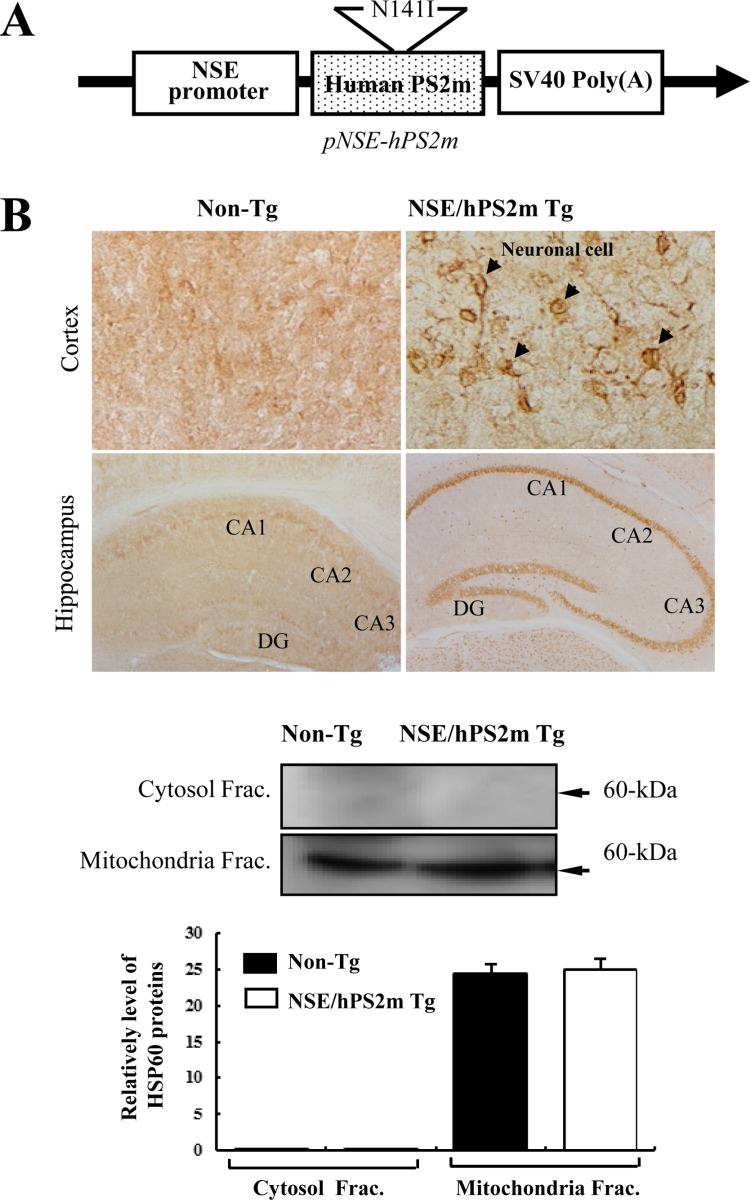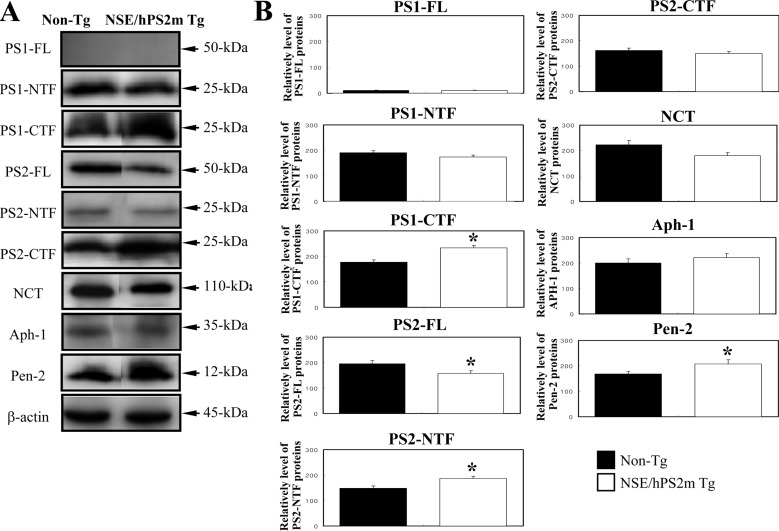Lab Anim Res.
2016 Dec;32(4):249-256. 10.5625/lar.2016.32.4.249.
Overexpression of N141I PS2 increases γ-secretase activity through up-regulation of Presenilin and Pen-2 in brain mitochondria of NSE/hPS2m transgenic mice
- Affiliations
-
- 1Department of Biomaterials Science, College of Natural Resources and Life Science/Life and Industry Convergence Research Institute, Pusan National University, Miryang, Korea. dyhwang@pusan.ac.kr
- 2Biologics Division, Ministry of Food and Drug Administration (MFDS), Cheongju, Korea.
- KMID: 2362917
- DOI: http://doi.org/10.5625/lar.2016.32.4.249
Abstract
- Alzheimer's disease (AD) is known to induce alterations of mitochondrial function such as elevation of oxidative stress and activation of apopotosis. The aim of this study was to investigate the effects of human Presenilin 2 mutant (hPS2m) overexpression on the γ-secretase complex in the mitochondrial fraction. To achieve this, alterations of γ-secretase complex expression and activity were detected in the mitochondrial fraction derived from brains of NSE/hPS2m Tg mice and Non-Tg mice. Herein, the following were observed: i) overexpression of the hPS2m gene significantly up-regulated the deposition of Aβ-42 peptides in the hippocampus and cortex of brain, ii) overexpression of hPS2m protein induced alterations of γ-secretase components such as main component protein and activator protein but not stabilization-related proteins, iii) changes in γ-secretase components induced by overexpression of hPS2m protein up-regulated γ-secretase activity in the mitochondrial fraction, and iv) elevation of γ-secretase activity induced production of Aβ-42 peptides in the mitochondrial fraction. Based on these observations, these results indicate that alteration of γ-secretase activity in cells upon overexpression of hPS2m is tightly linked to mitochondrial dysfunction under the specific physiological and pathological conditions of AD.
MeSH Terms
Figure
Reference
-
1. Weihofen A, Martoglio B. Intramembrane-cleaving proteases: controlled liberation of proteins and bioactive peptides. Trends Cell Biol. 2003; 13(2):71–78. PMID: 12559757.
Article2. De Strooper B. Aph-1, Pen-2, and Nicastrin with Presenilin generate an active gamma-secretase complex. Neuron. 2003; 38(1):9–12. PMID: 12691659.3. Kimberly WT, LaVoie MJ, Ostaszewski BL, Ye W, Wolfe MS, Selkoe DJ. Gamma-secretase is a membrane protein complex comprised of presenilin, nicastrin, Aph-1, and Pen-2. Proc Natl Acad Sci U S A. 2003; 100(11):6382–6387. PMID: 12740439.4. Yu G, Nishimura M, Arawaka S, Levitan D, Zhang L, Tandon A, Song YQ, Rogaeva E, Chen F, Kawarai T, Supala A, Levesque L, Yu H, Yang DS, Holmes E, Milman P, Liang Y, Zhang DM, Xu DH, Sato C, Rogaev E, Smith M, Janus C, Zhang Y, Aebersold R, Farrer LS, Sorbi S, Bruni A, Fraser P, St George-Hyslop P. Nicastrin modulates presenilin-mediated notch/glp-1 signal transduction and betaAPP processing. Nature. 2000; 407(6800):48–54. PMID: 10993067.5. Lee SF, Shah S, Li H, Yu C, Han W, Yu G. Mammalian APH-1 interacts with presenilin and nicastrin and is required for intramembrane proteolysis of amyloid-beta precursor protein and Notch. J Biol Chem. 2002; 277(47):45013–45019. PMID: 12297508.6. Steiner H, Winkler E, Edbauer D, Prokop S, Basset G, Yamasaki A, Kostka M, Haass C. PEN-2 is an integral component of the gamma-secretase complex required for coordinated expression of presenilin and nicastrin. J Biol Chem. 2002; 277(42):39062–39065. PMID: 12198112.7. Suh YH, Checler F. Amyloid precursor protein, presenilins, and alpha-synuclein: molecular pathogenesis and pharmacological applications in Alzheimer's disease. Pharmacol Rev. 2002; 54(3):469–525. PMID: 12223532.8. Teng FY, Tang BL. Widespread gamma-secretase activity in the cell, but do we need it at the mitochondria? Biochem Biophys Res Commun. 2005; 328(1):1–5. PMID: 15670741.9. St George-Hyslop PH. Molecular genetics of Alzheimer's disease. Biol Psychiatry. 2000; 47(3):183–199. PMID: 10682216.
Article10. Thinakaran G, Harris CL, Ratovitski T, Davenport F, Slunt HH, Price DL, Borchelt DR, Sisodia SS. Evidence that levels of presenilins (PS1 and PS2) are coordinately regulated by competition for limiting cellular factors. J Biol Chem. 1997; 272(45):28415–28422. PMID: 9353300.
Article11. Wang HQ, Nakaya Y, Du Z, Yamane T, Shirane M, Kudo T, Takeda M, Takebayashi K, Noda Y, Nakayama KI, Nishimura M. Interaction of presenilins with FKBP38 promotes apoptosis by reducing mitochondrial Bcl-2. Hum Mol Genet. 2005; 14(13):1889–1902. PMID: 15905180.
Article12. Hwang DY, Chae KR, Kang TS, Hwang JH, Lim CH, Kang HK, Goo JS, Lee MR, Lim HJ, Min SH, Cho JY, Hong JT, Song CW, Paik SG, Cho JS, Kim YK. Alterations in behavior, amyloid beta-42, caspase-3, and Cox-2 in mutant PS2 transgenic mouse model of Alzheimer's disease. FASEB J. 2002; 16(8):805–813. PMID: 12039862.13. Janicki S, Monteiro MJ. Increased apoptosis arising from increased expression of the Alzheimer's disease-associated presenilin-2 mutation (N141I). J Cell Biol. 1997; 139(2):485–495. PMID: 9334350.
Article14. Alves da Costa C, Paitel E, Mattson MP, Amson R, Telerman A, Ancolio K, Checler F. Wild-type and mutated presenilins 2 trigger p53-dependent apoptosis and down-regulate presenilin 1 expression in HEK293 human cells and in murine neurons. Proc Natl Acad Sci U S A. 2002; 99(6):4043–4048. PMID: 11904448.
Article15. van de Craen M, de Jonghe C, van den Brande I, Declercq W, van Gassen G, van Criekinge W, Vanderhoeven I, Fiers W, van Broeckhoven C, Hendriks L, Vandenabeele P. Identification of caspases that cleave presenilin-1 and presenilin-2. Five presenilin-1 (PS1) mutations do not alter the sensitivity of PS1 to caspases. FEBS Lett. 1999; 445(1):149–154. PMID: 10069390.16. Gandhi S, Muqit MM, Stanyer L, Healy DG, Abou-Sleiman PM, Hargreaves I, Heales S, Ganguly M, Parsons L, Lees AJ, Latchman DS, Holton JL, Wood NW, Revesz T. PINK1 protein in normal human brain and Parkinson's disease. Brain. 2006; 129:1720–1731. PMID: 16702191.17. Hansson CA, Frykman S, Farmery MR, Tjernberg LO, Nilsberth C, Pursglove SE, Ito A, Winblad B, Cowburn RF, Thyberg J, Ankarcrona M. Nicastrin, presenilin, APH-1, and PEN-2 form active gamma-secretase complexes in mitochondria. J Biol Chem. 2004; 279(49):51654–51660. PMID: 15456764.18. Newmeyer DD, Ferguson-Miller S. Mitochondria: releasing power for life and unleashing the machineries of death. Cell. 2003; 112(4):481–490. PMID: 12600312.19. Tsujimoto Y. Cell death regulation by the Bcl-2 protein family in the mitochondria. J Cell Physiol. 2003; 195(2):158–167. PMID: 12652643.
Article20. Green DR, Kroemer G. The pathophysiology of mitochondrial cell death. Science. 2004; 305(5684):626–629. PMID: 15286356.
Article21. Yuan J, Yankner BA. Apoptosis in the nervous system. Nature. 2000; 407(6805):802–809. PMID: 11048732.
Article22. Dickson DW. Apoptotic mechanisms in Alzheimer neurofibrillary degeneration: cause or effect? J Clin Invest. 2004; 114(1):23–27. PMID: 15232608.
Article23. Gabuzda D, Busciglio J, Chen LB, Matsudaira P, Yankner BA. Inhibition of energy metabolism alters the processing of amyloid precursor protein and induces a potentially amyloidogenic derivative. J Biol Chem. 1994; 269(18):13623–13628. PMID: 8175797.
Article24. Gasparini L, Racchi M, Benussi L, Curti D, Binetti G, Bianchetti A, Trabucchi M, Govoni S. Effect of energy shortage and oxidative stress on amyloid precursor protein metabolism in COS cells. Neurosci Lett. 1997; 231(2):113–117. PMID: 9291153.
Article25. Misonou H, Morishima-Kawashima M, Ihara Y. Oxidative stress induces intracellular accumulation of amyloid beta-protein (Abeta) in human neuroblastoma cells. Biochemistry. 2000; 39(23):6951–6959. PMID: 10841777.26. Busciglio J, Pelsman A, Wong C, Pigino G, Yuan M, Mori H, Yankner BA. Altered metabolism of the amyloid beta precursor protein is associated with mitochondrial dysfunction in Down's syndrome. Neuron. 2002; 33(5):677–688. PMID: 11879646.27. Yang AJ, Chandswangbhuvana D, Shu T, Henschen A, Glabe CG. Intracellular accumulation of insoluble, newly synthesized abetan-42 in amyloid precursor protein-transfected cells that have been treated with Abeta1-42. J Biol Chem. 1999; 274(29):20650–20656. PMID: 10400697.
- Full Text Links
- Actions
-
Cited
- CITED
-
- Close
- Share
- Similar articles
-
- Effects of Red Liriope platyphylla on NGF secretion ability, NGF receptor signaling pathway and gamma-secretase components in NSE/hAPPsw transgenic mice expressing Alzheimer's Disease
- Peroxiredoxin I regulates the component expression of gamma-secretase complex causing the Alzheimer's disease
- Presenilin 2 N141I Mutation Induces Hyperimmunity by Immune Cell-specific Suppression of REV-ERBα without Altering Central Circadian Rhythm
- Intracellular trafficking of TREM2 is regulated by presenilin 1
- Animal Models of Alzheimer's Dementia




